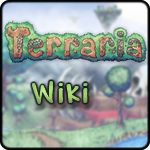Gardening is the practice of intentionally spawning resources in a convenient area for harvest. There are several Plants that can be successfully grown in gardens in Terraria.
To grow many items you'll first need to collect seeds.
Grass
| Seed | Creates | Planted In | Obtained By |
|---|---|---|---|
| Corruption | Dirt | Dryad during Blood Moon, dropped by Eye of Cthulhu if the world has the Corruption biome | |
| Hallow | Dirt | Dryad during Hardmode, except during a Blood Moon | |
| Grass | Dirt | Dryad, except during a Blood Moon | |
| Jungle | Mud | Sometimes dropped when clearing jungle grass | |
| Glowing Mushrooms | Mud | Dryad while in a Mushroom Biome, Sometimes dropped when clearing mushroom grass | |
| Crimson | Dirt | Dryad during a Blood Moon in a Crimson world, dropped by Eye of Cthulhu if the world has Crimson |
Ordinary grass and corruption spread fairly quickly, though grass requiring mud, like Glowing Mushroom and Jungle, is rather slow. Planting multiple seeds spread throughout the farm is advisable in those cases. Only one tree will grow per acorn planted. All mushrooms grow more abundantly when you trim the weeds often.
Alchemy
| Seed | Creates | Planted In | Obtained By |
|---|---|---|---|
| Dirt or Mud | Mature | ||
| Grass | Mature | ||
| Corruption or Crimson | Mature | ||
| Ash | Mature | ||
| Jungle Grass | Mature | ||
| Sand | Mature | ||
| Snow | Mature |
The Staff of Regrowth can be used to collect seeds from fully grown plants even while they are not blooming. This can make gardening much more effective.
Other
| Seed | Creates | Planted In | Obtained By |
|---|---|---|---|
| Trees | Grass on Dirt, Snow, Sand | Dryad, mature Trees | |
| Grass | Bought from the Dryad |
Potion and Seed Farm
A well planned seed garden will help cultivate the plants used to create a variety of potions. The individual seeds are listed above including soil type, harvest conditions, and special instructions. A good design can be easily expanded as needed.
There are 2 methods of growing herbs, Clay Pots and Soil planting. Soil farming is quicker to set up and harvest. Potted plant farming is safer and more versatile for small spaces. Both have equal set up times due to resource gathering if planning large farms. A combination of both is best but requires the most time.
Both methods are viable farming techniques, but each has its own strengths and weaknesses. Growing plants inside pots makes for precise harvesting, but is very very slow to harvest by comparison even with the fastest pick. Plants on soil can be harvested by simply running through with weapon swinging or use of a dart trap to cut all plants at once. Clay pots have the benefit, when not in use, of being a bait farm. Potted plant farms are not constrained by the 400 active item limit due to items immediately being picked up. With the use of actuators, soil farms can be quickly harvested but items over 400 will disappear beginning with the oldest.
When using soil planting, the need for harvesting plants is reduced due to the large supply given per yield. Once you start gathering 50-100+ herbs per harvest, having 2-3 out of the lot not fully grown per harvest is far less of an impact on total. If looking to have many spare consumable potions, Soil planting is the only known time efficient method of doing so.
When beginning a soil garden, it is possible to harvest individual plants by using seeds. Placing a seed on a bloomed herb will harvest the herb and recover any seeds dropped, leaving a seedling in its place. This is helpful when you are just starting to use soil planting, need a few herbs, but do not yet have a large stash of seeds. If you don't want to place seeds, you can also equip a campfire and swing it above the plants, but be careful not to place the campfire down. Thus harvesting from soil can be just as accurate as pot farming, but soil farms are still much more vulnerable to accidental harvesting or seedling destruction. (This method of harvesting may only work in single player.) Once they reach the blooming stage, they will continue to bloom under the conditions for that plant until you harvest them. So Daybloom will re-bloom each day, Moonglow each night, Waterleaf each rainfall, Deathweed each Blood Moon...[1]
Space requirements should also be considered, as plants require 2 blocks of vertical clearance using Clay Pots versus 1 block to grow on soil.
To quickly harvest your mushrooms and soil-grown plants, place a dart trap just to the left, on the same level with the plants, and wire a switch to the trap block. When activated, it will instantly uproot all the mushrooms or plants in that row. However, this method does not work on potted plants.
- Herbs.png
Potion farm using soil.
- SeedPotFarm.png
Potion farm using Clay Pots.
- Planter Box Farm.png
A simple Planter Box farm.
Note: Both of these pictures show Waterleaf blooming while submerged in water and Fireblossom blooming while submerged in lava. However, this is NOT the case in the current PC version of Terraria, as Waterleaf only blooms when it is raining and Fireblossom blooms at sunset (from 3:45pm to 7:30pm), and neither need to be submerged at all.
Moreover, space issues are less of a concern in potted plants with the introduction of Planter Boxes, which allow for dense farms fully harvestable using the Staff of Regrowth.
Trees
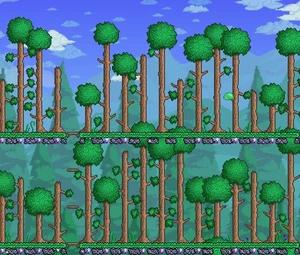
Layered tree farm.
A tree farm is usually nothing more than a wide, flat surface where players plant their Acorns. If the tree farm sees heavy use, players might level off the area more carefully. It is possible to layer tree farms, much like mushroom farms, but trees require far more height. Trees only grow as many as 16 blocks high, making this an ideal spacing. (Note that trees generated with the map are often much taller.)
Each sapling should have one empty space on either side of it, as well as an empty space between where the trees will be; underground markers such as torches may be used to make this easier. This means there will be three spaces between each acorn, as the first tree to grow may fill an additional space on either side of its trunk.
By placing a dirt wall inside the layer of grass blocks (not behind the tree, the block below the tree), one can prevent tall grass from spawning, maximizing efficiency. The dirt wall should peek out from behind the grass blocks and be visible behind the tree, but not actually being in the block behind the tree. The dirt wall should be behind every block of grass, not just the one under the tree.
A surface jungle may be more efficient in terms of effort, since the trees grow automatically. All that is required is a large, flat area of mud one block deep with Jungle Grass on the surface. The disadvantage is that it can take quite a while for enough trees to grow. Jungle trees also grow higher, up to 21 blocks, so they contain more wood, but also require more spacing if you wish to layer them. This is also a great way of obtaining green dye. However, keep in mind that surface jungle monsters such as Jungle Slimes, Bats, and Snatchers may spawn.
Note that the Jungle biome spawns less trees, and more bushes. To counter-act this, build two-block wide segments (two mud blocks and a one block gap, for example); this way, the 3 block wide bushes will not spawn, while trees will continue to spawn. Another way to counter-act this, make a single block deep farm with water. Trees will grow in the water, however bushes will not. The new hardmode mobs are more inconvenient now, however.
Also, Jungle trees yield Rich Mahogany and as such if your goal is to harvest regular Wood this method will prove ineffectual. However, many non-furniture recipes that require wood may accept any type.
Jungle
There are two major resources to gather from a jungle farm, Jungle Grass Seeds and Jungle Spores. Jungles require Mud to grow.
- Jungle Grass Seeds can be gathered both above ground and underground. The same layered methods used for mushroom farming work well here; be warned that the area will spawn jungle monsters. By creating an open-top area, trees will spontaneously grow, which is good for growing wood but not good for growing grass for seeds.
- Jungle Spores can only be found underground. Be warned that an underground jungle farm can spawn even more dangerous creatures including Man Eaters and Hornets. Bear in mind that in order to farm Jungle Spores, you need to create your farm in the Cavern layer.
- If you have the materials to spare, you can neutralize the risk of dangerous creature spawns by putting up background Walls as you would for NPC housing. Combine this with submerging the grass in a 1-block layer of water and you also prevent the large bushes (which drop nothing and cost you 3 tiles of potential grass) from appearing.
Underground Jungle farms will also occasionally grow Jungle Roses and Nature's Gifts. In Hardmode it can also spawn Life Fruits at random. Additionally, an underwater jungle farm can be created to farm Piranha for hooks and the rare Robot Hat.
Normal Mushrooms
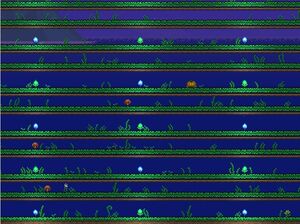
Compact mushroom farm.
Normal mushrooms will grow anywhere with normal grass. To make a normal mushroom farm, simply place several layers of dirt with gaps in between. The grass must be naturally lit. A compact farm can produce roughly 10-15 mushrooms per screen per harvest.
Note that vines will grow down from strips of grassy dirt, preventing the growth of mushrooms. To combat this, add a layer of stone (or other non-dirt block) under each layer of dirt. Wooden platforms are an excellent option here since the player can walk through them, allowing layers to be packed more tightly.
Glowing Mushrooms
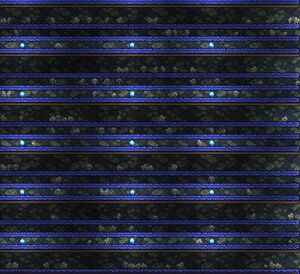
A compact glowing mushroom farm.
Glowing Mushrooms are perhaps the most worthwhile thing to intentionally grow. Glowing mushroom farms usually consist of several layers of mud with Mushroom Grass Seeds planted on them. Without the need to weed the farm of normal grass (as is the case with normal mushrooms) the Glowing Mushrooms yield astonishing results. One roughly the size of the screen can provide as many as 200 glowing mushrooms in a single harvest, enough to support multiple players with Healing Potions. However once players start crafting Shroomite Bars a larger mushroom farm may be useful.
Glowing Mushrooms do not need to be underground in order to grow. Mushroom Grass seeds, which can be easily obtained by weeding even the smallest mushroom biomes, can be placed on any mud block on any level, and in time, Glowing Mushrooms will grow. If enough Mushroom Grass is planted, the area around them will be converted into a Mushroom Biome, allowing access to different enemy types, and large tree-like Mushrooms to grow.
Vile/Vicious Mushrooms
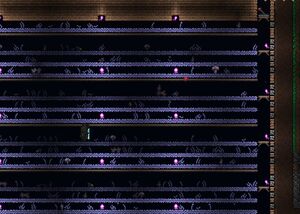
Safely bounded corrupt area.
Vile Mushrooms, and their bloodied counterparts Vicious Mushrooms, grow on their respective evil grass. Be aware that planted evil will spread like natural evil does, but this spread can be controlled using sunflowers, before activating hardmode. If it's close enough to your NPCs, the reduction in enemy spawns will keep anything from showing up. Alternately you can place platforms (on which enemies can't spawn) to prevent them from spawning (see image to the right). Evil mushrooms need to be in an area big enough to dim the sunlight, and they need to be naturally lit as with normal mushrooms above.
If your world is in hardmode, you should take extra care to surround your farm in the hallow, or anything else that can't be corrupted. You can also leave a 4 blocks wide open space to prevent the corruption from spreading. (Note that Thorny Bushes can grow in empty spaces, so you still need a single layer of incorruptible blocks before doing so.
This area may also serve as an arena for fighting the Eater of Worlds or the Destroyer (see below). It is also possible to summon Brain of Cthulhu here in Crimson worlds. Note that an area of wooden platforms is recommended for the actual fight, however they may be summoned from within the farm.
You can also put three connected lines of dirt in the air, and replace every second dirt in the middle line, then place a corrupt seed/crimson seed on any one of the dirt to make a nice vile/vicious mushroom farm in the air, but be cautious that it may be considered as a real corruption/crimson so you may not want to do this in a hardmode world.
Mushroom & Glowing Mushroom Farm Layouts
It is possible to create higher yield mushroom farms by placing multiple mushroom layers between harvesting layers. In this sort of layout mushroom layers are stacked between harvesting layers to create a much more efficient farm. A mushroom layer is a layer air, followed by a layer of normal grass (for normal mushrooms) or mushroom grass (for Glowing Mushroom), and, if for growing normal mushrooms, next by a layer of stone (or any other tile but dirt or air) to keep vines from blocking mushroom growth. A harvesting layer is simply a layer of non-solid tiles 3 blocks high for the player to go though to harvest their mushrooms. Ideally a harvesting layer will have platforms as it's topmost layer if the farm is for regular mushrooms, as it can double as the bottom layer of the mushroom layer above.
For an efficient mushroom farm, mushroom layers are stacked 2 high, followed by a harvesting layer, followed by another set of mushroom layers. A glowing mushroom farm follows the same layout, but the mushroom layers can be stacked up to 3 high.
To harvest this type of farm a swinging weapon with a longer reach (such as a broadsword or Muramasa) is suggested as they can easily reach and harvest the in-between mushroom layers. There are many other possible layouts for a high-yield mushroom farm.
A convenient (but expensive) method is to add layers of mud in a proper manner, skipping a space between each, then wiring each block up with Actuators. This allows the entire farm to be harvested with a flick of a switch. A solid layer should be kept at the bottom to catch all the falling mushrooms and seeds, and enough time should be allowed to pass after making the blocks inactive for all the materials to fall to the bottom layer. While such a thing is time consuming and expensive (each actuator must be purchased from the Mechanic), it can be worthwhile in the long run, as it allows the harvesting of hundreds of shrooms within moments.
Bait Farm
Lay out long rows of dirt with blocks at each end to stop the bait from escaping. Put wooden platforms every so often, so you can go up layers of dirt. It may also be useful to have a wood farm on the top layer.
Clay pots can also be a good source of bait in the form of worms and grasshoppers. Flowers grow out of them by default and when you cut the flowers down, worms and grasshoppers pop out. This can be used in conjunction with herbs for potions when you need them. Worms and grasshoppers only pop out from the default flowers and not planted herbs used in potions.
A third type would require hallow seeds or holy water. With this, create housing about 40 blocks above a patch of dirt 500 blocks long. With enough NPCs, no monsters will spawn. Spread the hallow seeds out and during the day, butterflies will appear or even better, lightning bugs at night. Hallow seeds can only be obtained after the wall of flesh has been defeated. With the help of a water candle, butterfly and bugs should spawn pretty quick. To avoid eclipses and pirate attacks you should do this on a newly created world.
Jungle grass is also an excellent source of bait. Each plant has a very high chance of spawning a grubby, buggy, or sluggy.
Jungle Bait Farm
This farm can be done at any layer of the Jungle.
Dig out an array of 3 wide tunnels in the Jungle separated vertically by 2 blocks. In the middle of these tunnels, dig a 3 wide tunnel straight down to separate them horizontally. At the bottom of each vertical separator, place any block other than mud to prevent grass from growing on the ceiling to further prevent vine growth. Given some time, many bushes will grow allowing you to farm jungle bait.
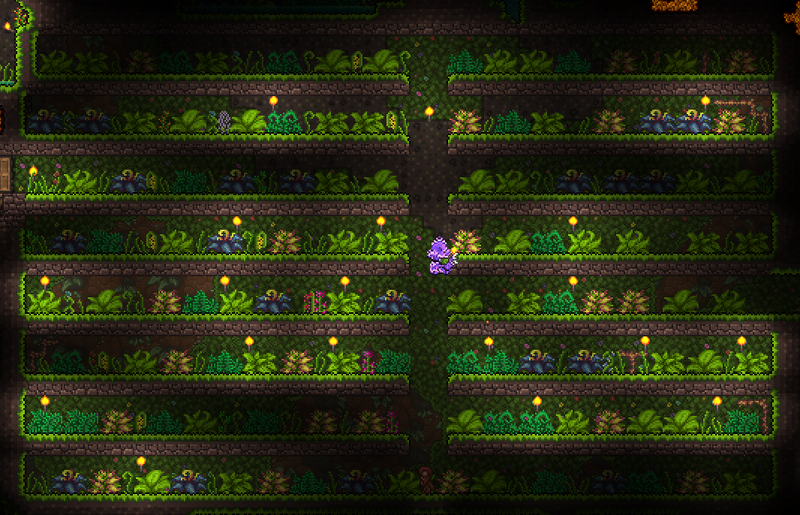
A player standing in a jungle bait farm
